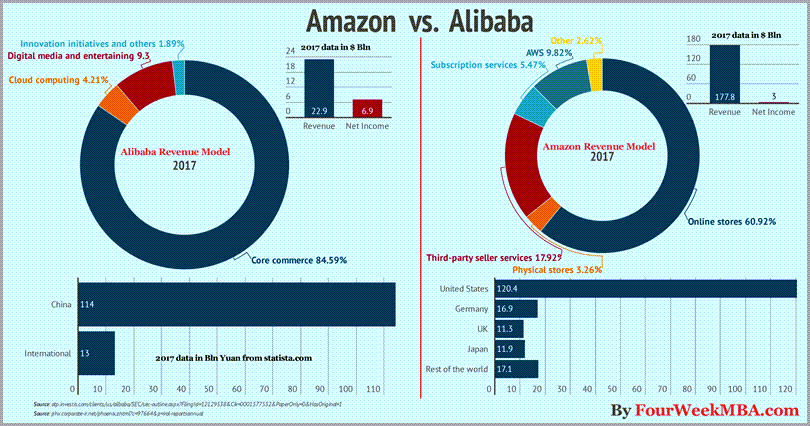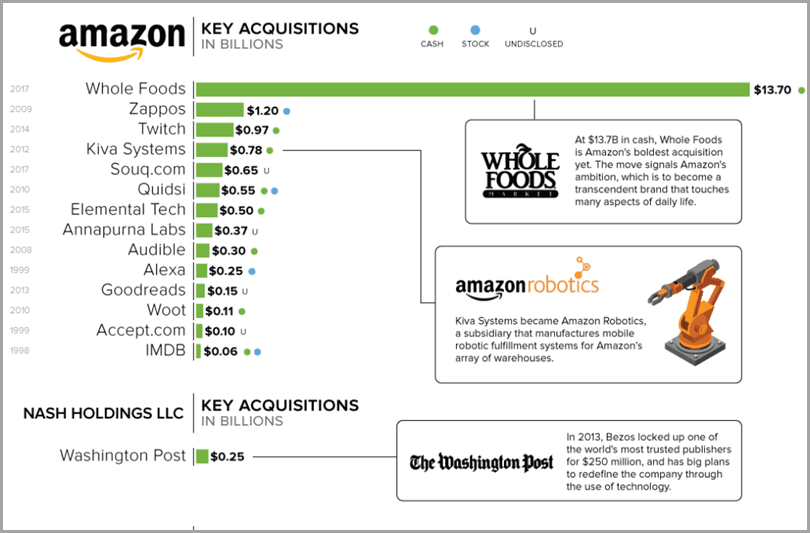Secret eCommerce Strategies of Amazon, Alibaba, & eBay
By: Jeff Bullas

Ever since the pandemic (COVID-19) has hit global health and the economy, many businesses are struggling to cope with current scenarios.
People are avoiding public places to avoid the spread of the virus, thus making the brick and mortar store irrelevant for some time.
Businesses have to focus their efforts on online channels and engaging their customers to order from them. To regain the foot count and profits during the pandemic, businesses are shifting from traditional brick and mortar stores to online eCommerce stores.
 Retail eCommerce website traffic stats worldwide after Feb 2020.
Retail eCommerce website traffic stats worldwide after Feb 2020.
When I mention the term “eCommerce,” a few big names come to mind, Amazon, eBay, and Alibaba. We know the success these online marketplaces have witnessed, but do we consider the struggles these companies went through to become the industry monsters that they are today?
The history of eCommerce giants Amazon, Alibaba, and eBay
Jeff Bezos started Amazon as a website that only sold books, and his vision was for the company’s explosive growth and eCommerce domination.
Amazon started in Bezos’ garage, and the server required so much power that a dryer or vacuum could not be operated without fusing the electricity.
Amazon held its meeting in Barnes and Noble during the early stages, and in the first month itself, Amazon sold in 50 states in 45 countries. Every step taken by Amazon was not only to grow the business but to set a benchmark in the eCommerce sector.
Lesser-known fact: When deciding the name for the business, Bezos favored the name: Relentless. If you still visit Relentless.com. It navigates to Amazon.com.
Jack Ma is the founder of Alibaba, a strong competitor for Amazon in the Chinese market. His struggle in his early childhood to become a famous entrepreneur is a real rag to riches story. He grew up in poor communist China and failed his university exam twice. Jack Ma – born – Ma Yun applied to dozens of jobs where he was rejected. He also applied to KFC, where he was rejected as a suitable candidate.
When eBay launched, Bezos wanted to adopt the business model of auction websites. He tried to launch an auction website to compete with eBay, but the idea was a flop.
Businesses struggle to stand in the market, even Amazon or eBay in its early days struggled to become relevant. A business strategy that will ensure growth is necessary for every business to stay relevant in the ever-changing market.
Amazon, eBay, and Alibaba have not just evolved themselves but the whole eCommerce sector. Startups and SMBs take inspiration from these businesses before starting their online marketplace.
Here are some of the growth strategies that eCommerce behemoths used to become popular eCommerce brands.
Business models
When you think about starting an eCommerce business, you start by analyzing the market leader that is working on a similar business model. If you carefully check the business model of eCommerce giants, you will notice a huge difference.
Alibaba dominates the Chinese retail industry and works on the asset-light business model. The business does not store the inventory of businesses selling on the platform; it merely connects the buyers with the seller. The business revenue model depends on core commerce, digital media, entertainment, and innovative initiatives.
Amazon is growing through a competitive edge of fulfillment and delivery. Amazon, unlike Alibaba, owns some of the inventory of its merchandise and sells directly to customers. Amazon is currently twice as big as Alibaba, with a market capitalization of $800 billion. The core revenue source of Amazon is online, 3rd party seller service, subscription, and advertisement.
 Image Source: FourWeekMBA.com
Image Source: FourWeekMBA.com
eBay originally started with a P2P business model and started to sell products based on the auction-style sale. As the business grew, it started its ‘buy now’ option, which allows sellers to sell products to customers directly.
Customer policies
eCommerce websites keep evolving according to the latest market trends. Any eCommerce website should formulate policies and functionalities to keep the customer experience seamless. One way to judge how eCommerce stores are improving the customer’s experience is by checking the website of eCommerce giants and the transformation that they have gone through.
Amazon was launched in the year 1995. The logo of the website was “A” with a winding river flowing through it. On the bottom of the logo, the Amazon bookstore was written. In the year 2008, Amazon redesigned itself completely. The site embraced a blue and orange color scheme, complementing the orange from the logo’s smile.
 Image Source: Amazon Logo History
Image Source: Amazon Logo History
Alibaba makes policies and functionality based on the data they collect. Alibaba collects a lot of data from the customer’s purchase journey, making it easy for them to devise new strategies or adventures for customers.
Business acquisitions and new ventures
When a business, whether it is eCommerce or offline, gets through its early days and becomes stable, they want to expand. Expanding means spreading wings into new industries or sectors and acquiring other relevant businesses.
These eCommerce businesses moved forward in leaps and bounds as their vision was to revolutionize the eCommerce sector and create a benchmark for businesses to follow. New technologies adopted by these businesses always focused on making the process easier for consumers and sellers.
Amazon became a giant due to its ventures and acquisitions. An essential venture which has been the talk of the town for a long time is Amazon Prime. Prime membership allows customers not only to get delivery in a single day but opens up an array of movies and music on a subscription basis. Amazon also launched Alexa or echo dot, which is a virtual assistant device. The turning point for Amazon was when they acquired the Kiva system, and the most economically significant acquisition was when Amazon acquired Whole Foods.
Amazon spent $775 million for the Kiva system and has been one of Amazon’s three most significant acquisitions. Re-dubbed, as Amazon robotic, is involved in innovation in logistics and warehousing. The operation focuses on small robots that can carry 540 kgs per unit from one place to another. The robots’ working depends on sensors that avoid them from colliding with each other, and the barcode on the floor guides them to the destination.
 Image Source: Startupflux.com
Image Source: Startupflux.com
After receiving success in its industry, Alibaba’s revenue models were innovative initiatives, making it grow new ventures like Taobao Marketplace, Tmall, Rural Taobao, AliExpress, Lazada, and Alibaba Cloud. Each of these ventures contributed something significant to the business model and helped raise Alibaba to its current standing.
Due to the uniqueness in the business model of eBay, it acquired businesses of all sectors. It has moved from one sector to another, thus acquiring businesses in the process.
Also, these brands build partnerships with micro and macro influencers to generate awareness and drive traffic to their websites. Influencer marketing has really helped these brands to grow fast.
Seller-friendly policies
For an online multi-vendor eCommerce marketplace, customers are essential, but the sellers’ role is equally important. The whole ecommerce marketplace depends on the sellers and the inventory they maintain. For the admin to maintain a good rapport with the seller, they need to innovate policies and features that will make it easier for the seller.
Here are some the ways Amazon and Alibaba have curated seller friendly policies:
Amazon has a Fulfillment by Amazon (FBA) option, which eases the sellers from shipping and delivering their products to the customers. The seller can store the products in Amazon inventory, and Amazon will take the responsibility to pack the item and deliver it to the end customer. A seller-friendly policy allows the seller to scale their business faster and sell products to more and more customers.
Alibaba also follows the seller-friendly marketplace model but focuses on it differently. Unlike Amazon, Alibaba doesn’t charge transaction or commission fees to sellers. There is a one-time membership (Basic & Premium) charge. This also makes it convenient for the seller and ensures loyal sellers on the platform.
Technology
Choosing technology is the most crucial factor to scale up to different markets quickly. The fundamental requirement for any online marketplace to operate is the software. For the user interface and user experience of the website, the software or solution must be well equipped with tools and functionalities.
If you plan to get it developed from scratch from a developer or company, you need to have an understanding of the development and some technical skills to comprehend the functionalities you may need when you want to grow to the global market. Instead of building it from scratch, choosing a turnkey solution like Yo!Kart is a great choice to start an online eCommerce marketplace.
Entrepreneurs have to think ahead when selecting the technology through which they will be launching their eCommerce marketplace. Does the solution that you are choosing for your platform have features that will support your growth strategies?
Finally
In this post, I aimed to inspire budding entrepreneurs by the success stories of leading eCommerce brands. Though most aspiring entrepreneurs in the eCommerce sector want to become the next Amazon or eBay, what they do not realize is the struggle and challenges these eCommerce brands had to face to become eCommerce monsters.
For an eCommerce business to become successful, it has to carefully curate the business model, policies, and revenue streams. Once the business has its initial kick-start to remain relevant in the future, it has to focus on acquisitions and new ventures.
Following the footsteps of these eCommerce brands might be helpful but bringing innovation according to the niche and target audience is the key to success.
Guest author: Ankush Mahajan works as a senior digital marketer at FATbit Technologies, one of India’s leading custom web design/development & ready-made e-commerce solutions company. His expertise lies in branding and formulating marketing strategies for business of a number of industries. Follow him on twitter: https://twitter.com/ankushmahajann
The post The Secret eCommerce Growth Strategies of Popular Online Marketplaces Like Amazon, Alibaba, and eBay appeared first on Jeffbullas’s Blog.













